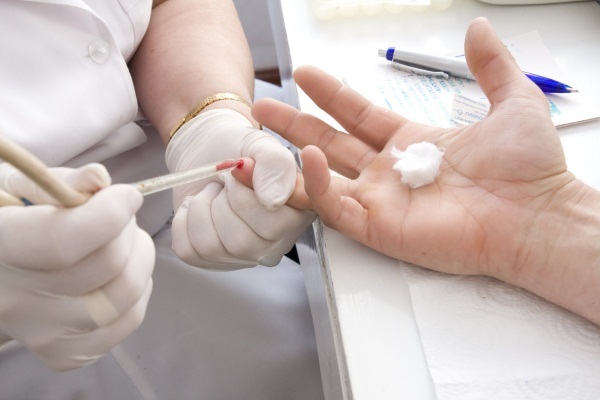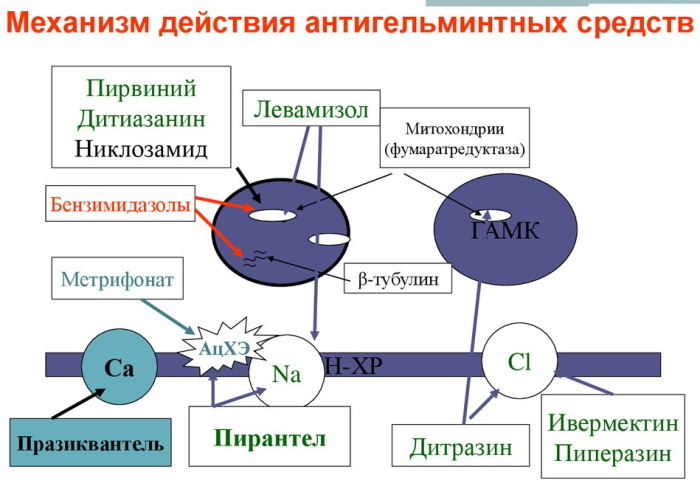Content
- Indications for analysis
- Features of the
- Indicators in the composition
- How it stands
- Hemoglobin
- Erythrocytes
- Leukocytes
- Hematocrit
- Color index
- Reticulocytes
- Neutrophils
- Eosinophils
- Monocytes
- Basophils
- Lymphocytes
- Platelets
- ESR
- What can affect the results?
- How do the indicators of a general blood test change during pregnancy?
- CBC video
A clinical blood test is taken for the timely diagnosis of health in adults and children. Deciphering the indicators allows medical specialists to fix deviations, which may indicate the development of a latent or overt disease.
Indications for analysis
A complete blood count is prescribed for both children and adults and is an important tool for diagnosing and monitoring the development of the body. This analysis includes the difference in parameters, each of which speaks about how the body is currently working.
Depending on the test results obtained, treatment is prescribed or recommendations are made by the attending physician. So, for example, if during the diagnosis a low level of leukocyte content in the blood is detected, then this tells the doctor that the body is not able to fight the infection.
Deciphering a clinical blood test in adults allows you to identify chronic dangerous diseases that go unnoticed in everyday life, bother little or completely asymptomatic.
Features of the
A blood sample is taken for a general analysis in the morning on an empty stomach. In an office specially equipped for this.
When taking blood, the specialist uses:
- Harness. To fix the arm and improve blood flow to the arm. Also, the patient is asked to clench and unclench the fist to improve blood flow.
- Vacuum tube. Used to transport biomaterial.
- Cotton wool. It is used for disinfection with an antiseptic of the skin area.
- Antiseptic. Medical alcohol. Used to disinfect the injection site.
- Bactericidal plaster. The specialist fixes the cotton wool with an antiseptic with a plaster to avoid the entry of microbes into the blood and to stop the blood.
The very technique of taking a biomaterial by a specialist changes depending on where the biomaterial is taken from: from the blood of a vein or from a finger. The differences between capillary and venous blood can be seen in the table below.
The basic and most commonly practiced blood collection technique includes:
- Preparation of the workplace and instruments for blood collection. These are test tubes, napkins, cotton wool, tourniquets, antiseptics and so on.
- A tourniquet is applied to the patient's arm, from the vein in which blood will be drawn, approximately 10 cm above the injection site. To improve blood flow, they are asked to clench and unclench a fist.
- The venipuncture site is disinfected. A syringe is inserted.
- The tourniquet is removed immediately after the blood enters the tube.
- After filling the tube, it is detached from the holder. The needle is disposed of.
- A sterile piece of cotton wool is applied to the injection site. A plaster is glued.
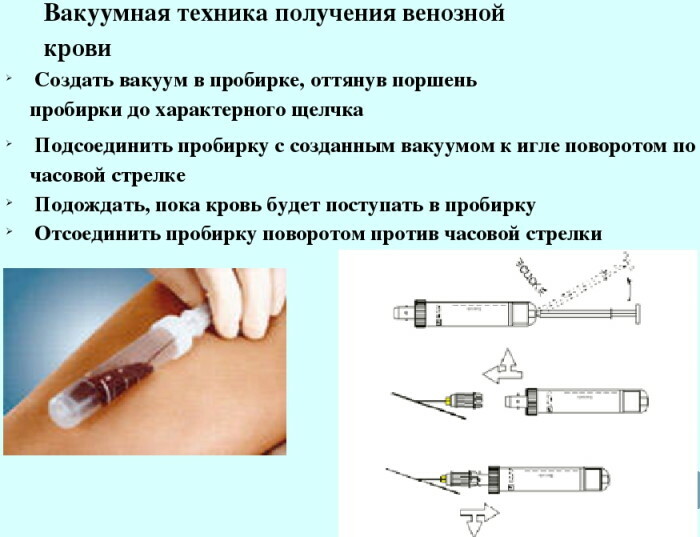
Decoding of a clinical blood test can be performed using 2 types of blood. However, the venous blood sample is collected primarily from adults.
In order to better understand why venous blood is taken more often, their characteristics can be compared.
| Venous | Capillary |
|
|
Thus, venous blood provides:
- The pressure of fluid necessary for blood sampling, which greatly facilitates the procedure.
- Traces of the functioning of organs, by which it is easier to identify pathology.
- Venous blood tests are more valid than capillary blood tests.
Differences in capillary blood sampling are:
- A simple procedure for taking biomaterial (blood). Since a harmless fingerprint test is used. This also explains why capillary blood collection is predominantly done in young children.
- Insufficient accuracy of test results.
The analysis involves the intentional preparation of the patient for the procedure, adherence to certain recommendations in the coming days before blood sampling, among which the most important specialists single out:
- The last meal should be at least 8 hours before blood sampling. It should not be plentiful so that all food has time to be digested.
- Alcohol and smoking must not be taken 2 days before blood sampling.
- It is not recommended to eat especially fatty foods in the next 2 days before blood sampling.
- It is not recommended to include intense cardio or strength training on the days before blood sampling.
- It is not recommended to visit saunas or baths in the coming days before blood sampling.
- It is not recommended to include for preventive or therapeutic purposes the intake of new medicines or preventive medicines, herbs.
- Refuse to take dietary supplements.
- Try to avoid stress and strong emotional turmoil.
- Postpone blood sampling if the patient has recently been examined in the X-ray room.
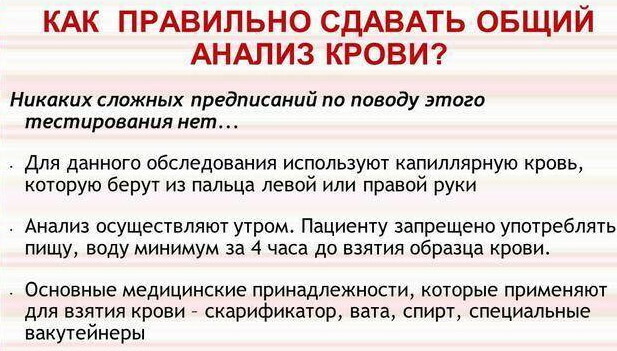
In addition to the hospital, the collection of biomaterial can be done at home. This service is available for patients who, for some reason, cannot leave the house. The procedure does not change significantly depending on where the analysis is performed.
The mechanism of blood sampling itself is carried out using a vacuum system - this is a syringe familiar to many, which consists of: a disposable holder, a double-sided disposable game and a sterile vacuum test tubes.
It is important during the analysis not to bring the infection into the body. Therefore, the specialist must use only sterile instruments, disinfect the area of the body from which the blood will be taken, and treat the hands.
The decoding of the clinical blood test in adults is carried out already in the laboratory. Biomaterials are transported there for further analysis by diagnostic specialists.
Indicators in the composition
Depending on which specialist prescribed a general blood test, there may be general and certain additional indicators.
Typically, this analysis includes the following main indicators:
- The number of leukocytes.
- Platelet count.
- Hemoglobin level.
- Red blood cell volume.
- The volume of hemoglobin in the erythrocyte.
- The volume of one platelet, etc.
In total, there are a total of up to 24 indicators from three groups: erythrocyte indices, platelet, leukocyte.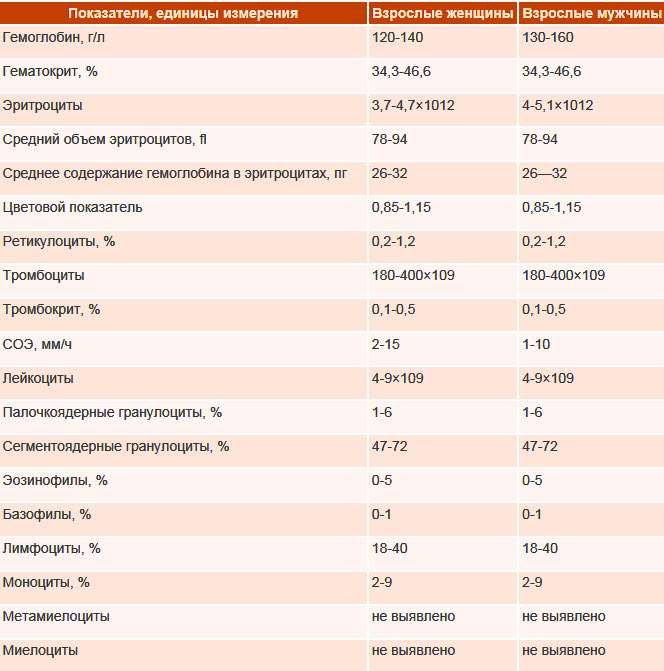
The erythrocyte index allows you to diagnose health problems associated with oxygen transport. So, for example, an increase in the number of red blood cells can help diagnose neoplasms in internal organs in time.
The leukocyte index allows you to identify hidden diseases associated with leukocytes - blood cells that form, mainly, human immunity, resistance to external influences. Therefore, an increase in leukocytes often indicates inflammatory processes, while a decrease in cell concentration may indicate anaphylactic shock or aplasia.
Also, with the help of the leukocyte index, it becomes possible to diagnose the leukocyte formula, otherwise called the leukogram. It is known that there are several types of white blood cells. Accordingly, with the help of the analysis, the doctor finds out what kind of inflammation prevails in the patient's body.
How it stands
In the biomaterial used for analysis, a liquid part is isolated - in fact, blood plasma, and cells contained in the blood - shaped bodies that "float" in the liquid part.
Cells have different functions:
- Protection from external influences. This is human immunity. Immunity is congenital, acquired. There are allergic reactions - errors of the immune system. There are also autoimmune reactions. Errors in which the immune system attacks not other people's bodies, but its own body.
- Transport of substances. These are glucose, oxygen and other useful molecules that are necessary for all cells of the body, but are reproduced only in some. For example, cells without oxygen die from hypoxia. Therefore, the transport of this substance is very important.
Plasma provides transport of substances. Without the liquid part of the blood, it simply would not be able to circulate in a circle. Also, the rate of transport of substances and, consequently, the rate of chemical reactions in the body depends on how liquid the blood is.
The decoding of the clinical blood test in adults includes the indicators presented in the table with the reference values.
Indicators are used taking into account the gender of middle-aged adults 20-50 years. The norms for are also indicated for children aged 1 to 6 years.
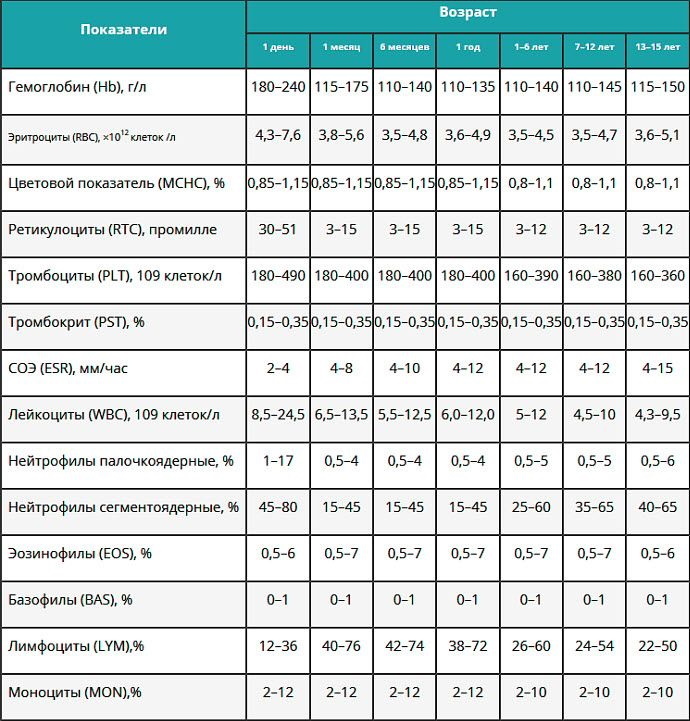
| Index | Decoding | Reference values | ||
| F | M | D | ||
| Hemoglobin | A type of protein that transports oxygen to organs and tissues. | 120–155 | Hemoglobin | A type of protein that transports oxygen to organs and tissues. |
| Hematocrit | The volume of hemoglobin to all formed elements and the total blood volume. | 38%–47% | Hematocrit | The volume of hemoglobin to all formed elements and the total blood volume. |
| Erythrocytes | Cells that carry out a transport function and carry oxygen. They contain hemoglobin. | 3,5–5 | Erythrocytes | Cells that carry out a transport function and carry oxygen. They contain hemoglobin. |
| Average volume of erythrocytes | The volume of hemoglobin in the erythrocyte. | 80–95 | Average volume of erythrocytes | |
| Average hemoglobin content in erythrocytes (MCH) | The quantitative content of hemoglobin in the erythrocyte. | 26–34 |
Average hemoglobin content in erythrocytes (MCH) | The quantitative content of hemoglobin in the erythrocyte. |
| Color index | The relative number of molecules of the protein hemoglobin, which gives a red color, in a single erythrocyte. | 0,85–1,05 | Color index | |
| Reticulocytes | Cells from which erythrocytes are subsequently formed. | 2%–10% | Reticulocytes | |
| Platelets | Cells in the blood that form platelet aggregates. They prevent vascular damage. | 150–400 | Platelets | |
| Thrombokrit | Platelet volume in relation to total blood volume. | 0.12–0.16 | Thrombokrit | |
| ESR | It characterizes the rate at which cells that carry oxygen - erythrocytes - settle. | 1-14 mm / h | ESR | It characterizes the rate at which cells that carry oxygen - erythrocytes - settle. |
| Leukocytes | Cells, the main function of which is to protect the body from external influences. | 4-10.4x109 | Leukocytes | Cells, the main function of which is to protect the body from external influences. |
| Rod granulocytes (neutrophils) | The type of neutrophils that are their precursors. | 1%–6% | Rod granulocytes (neutrophils) | |
| Segmented granulocytes (neutrophils) | Type of neutrophils. They are a type of white blood cell. This is innate immunity. Formed from stab granulocytes. | 45%–70% | Segmented granulocytes (neutrophils) | |
| Eosinophils | Subspecies of leukocytes. The main function is the destruction of multicellular parasites. | 0%–5% | Eosinophils | |
| Basophils | Subspecies of leukocytes. Participate in allergic reactions. An increased level of basophils indicates an allergy. | 0%–1% | ||
| Lymphocytes | Subspecies of leukocytes. Participate in the regulation of other immune cells. They are considered the main immune cells of the body. | 18%–40% | Lymphocytes | |
| Monocytes | Subspecies of leukocytes. Also referred to innate immunity. In addition, they react to inflammation. | 2%–9% | ||
| Metamyelocytes | Precursor of granulocyte myelocyte. | – | Metamyelocytes | Precursor of granulocyte myelocyte. |
| Myelocytes | A cell that identifies bone marrow inflammation. | – | Myelocytes | A cell that identifies bone marrow inflammation. |
Hemoglobin
Hemoglobin is a substance responsible for the red color of blood. It is a type of protein present in the red blood cell that transports oxygen to the main organs. The pathology of hemoglobin can be fatal to the body.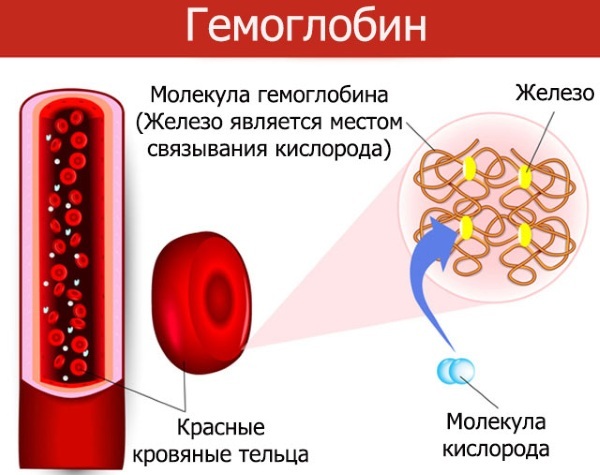
The norm of hemoglobin for adults: M - 125-165, F - 120-155. For children - 108–132.
Erythrocytes
Disturbances with the level of red blood cells in the blood are associated with the saturation of human organs and tissues with oxygen. So, a low level of red blood cells indicates oxygen starvation. However, neither increased nor decreased levels of red blood cells are, in themselves, a disease.
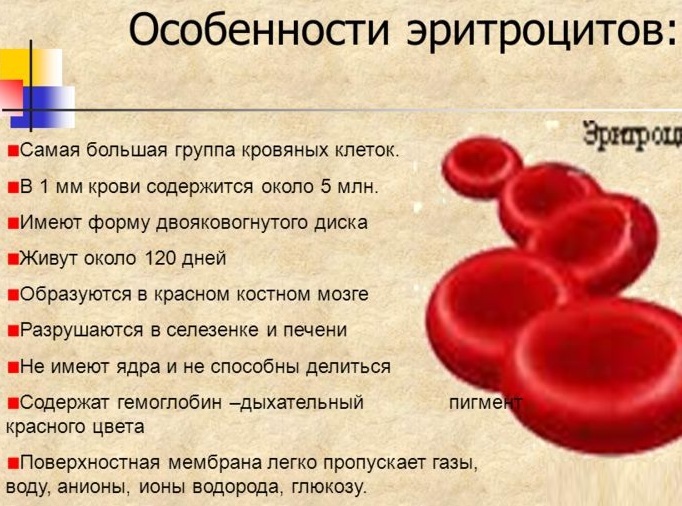
The norm of erythrocytes for adults: M - 3.9-5.6, F - 3.5-5. For children - 4.0–4.4.
Leukocytes
These are the cells responsible for immune responses in the body. Their high concentration may indicate inflammatory reactions occurring in the body at the moment.
The norm of hemoglobin for adults: M - 4.2-9x109, F - 4-10.4x109. For children - 5.5-15.5x109
Hematocrit
Otherwise, the concentration of red blood cells in the blood. A high level of red blood cells in the blood indicates a thickening of the blood. Conversely, a low level indicates insufficient viscosity.
The norm of hematocrit for adults: M - 42% –50%, W - 38% –47%. For children - 32% -42%
Color index
Expresses the relative concentration of hemoglobin, containing oxygen, in one erythrocyte cell. Low values of the color index indicate pathology. Statistically, the most common diseases associated with iron deficiency are anemia.
The norm of the color index for adults: 0.85-1.05. For children - 0.8-1.
Reticulocytes
These cells are the precursors of red blood cells. The concentration of reticulocytes in the blood indicates the norm or pathology of the human bone marrow.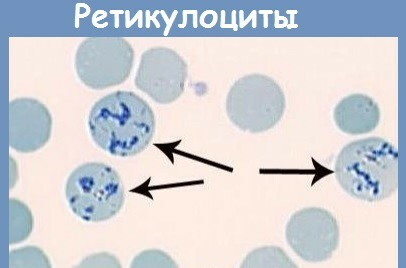
The rate of reticulocytes for adults: 2% -10%. For children - 2% –13%.
Neutrophils
Neutrophils are the most abundant type of white blood cell circulating in human blood. He participates in reactions aimed at attacking infections and viruses. Normally, neutrophils respond only to foreign hostile organisms.
The rate of stab neutrophils for adults: 1% –6%. For children - 0% –5%.
The rate of segmented neutrophils for adults: 45% –70%. For children - 39% –60%.
Eosinophils
It is a type of white blood cell that is involved in the immune system. Eosinophils actively respond to inflammatory processes in the body. In particular, they are associated with allergic reactions.

An increase in eosinophils can be caused by parasites, allergies, or asthma. Improper habits, in particular, food, and medications can also cause an increase.
The rate of eosinophils for adults: 0% –5%. For children - 1% –5%.
Monocytes
Mature white blood cells react to large hostile microorganisms: bacteria and microbes. In the analyzes, not only their concentration is often assessed, but also the ratio of monocytes to other types of leukocytes.
Monocyte rate: 2% –9%.
Basophils
Basophils are a subspecies of leukocytes. These cells actively respond to allergic reactions. They are involved in the development of anaphylactic shock when exposed to an allergic substance.
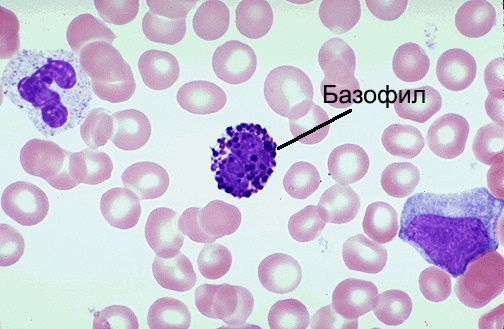
Basophil rate: 0% –1%.
Lymphocytes
Lymphocytes are a group of white blood cells that recognize and respond to genes from foreign organisms. With their help, the formation of an immune response to foreign genes is carried out.
Lymphocyte count for adults: 18% –40%. For children - 29% –50%.
Platelets
Without a normal concentration of platelets in the blood, blood clotting and protection of damaged vessels becomes impossible. Normally, platelet cells are called upon to protect the body from bleeding.
An increased or decreased level of platelets can indicate various diseases. In particular, the most common consequence is blockage of veins, thrombosis.
Platelet count for adults: M - 150-400. For children - 198–375.
ESR
Deviations from the norm indicate the effect of infectious diseases on the body. Also, the cause of increased or decreased ESR can be autoimmune diseases, metabolic pathologies or tissue necrosis.
Changes in ESR characterize the body's response to treatment or indicate the development of a disease. This allows you to diagnose the disease before its symptomatic manifestation.
ESR norm for adults: M - 2–20 mm / h, F - 1–14 mm / h. For children - 5-11 mm / h.
What can affect the results?
CBC results can be influenced by factors such as:
- Demographic: gender, age.
- Emotional stress.
- Physical stress.
- Food.
- Drink.
- In women, the phase of the menstrual cycle.
- Inflammatory processes.
- Exacerbation of chronic diseases.
The gender and age of the patient, although they affect the test results, of course must be taken into account by the attending physician, including the history of the family tree and the patient himself. Only a holistic picture allows us to make a reliable diagnosis.
Strong experiences cause a variety of biochemical changes, not only in the brain, but in other organs. Starting from the secretory glands, for example, the thyroid gland, and ending with the peristalsis of the stomach.
Deciphering a clinical blood test in adults strongly depends on the fear of taking a biomaterial. Prolonged stress can lead to a decrease in the level of iron in the blood and, as a result, suspicions of anemia arise.
Muscle tension and destruction during training also switch metabolic processes in the human body. So, for example, predominantly the body is not in a catabolic state, but in an anabolic state - then eating synthesizes new tissues, and does not destroy them, which is why both hormonal and molecular imbalance.
During recovery from exercise, fatty acid concentrations change. The concentration of ammonia, AST and LDH increases. Blood clotting increases, platelets are activated.
One of the most important components that affect many indicators of a complete blood count. For example, consuming sugary foods before testing can significantly increase blood sugar levels.
Dehydration is one of the reasons why molecules necessary for correct analysis results are destroyed.
Depending on the phase of the cycle, not only changes were noticed in the endocrine system (for example, the prevalence of progesterone hormones), but also in the molecular system (an increase in leukocytes in the blood).
Inflammatory processes noticeably increase the content of immune cells in the blood - leukocytes.
How do the indicators of a general blood test change during pregnancy?
During pregnancy, a number of adaptive and protective mechanisms are triggered in a woman's body to ensure the safety of the mother and the unborn child. The strongest changes are fixed in the concentration of sex hormones.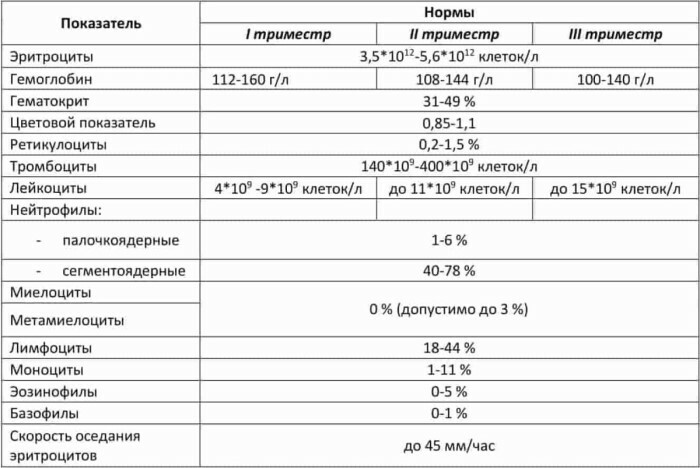
In a pregnant woman, the following indicators of a general clinical blood test change:
- The total protein in plasma decreases.
- Cholesterol doubles.
- The concentration of leukocytes increases by almost one and a half times.
- The concentration of stab neutrophils increases by one and a half times.
- The lower threshold of the normal concentration of segmented neutrophils increases.
- The concentration of eosinophils decreases.
- The erythrocyte sedimentation rate is doubled.
From the point of view of organ changes, for example, the uterus changes the most. In this organ, scientists observe an increase in blood volume, which is aimed at protecting the mother in case of bleeding. The blood supply to the liver and kidneys improves. The work of the endocrine glands is accelerated.
The thyroid gland increases and, accordingly, the concentration of the T4 hormone increases. It is also associated with an acceleration of the general metabolism in a pregnant woman. The metabolism is especially accelerated in the first half of pregnancy.
Due to changes in the hormonal background, the amount of transport proteins in the blood also increases, which directly affects the results of both the general blood test and the proteinogram.
The total circulating blood volume also changes in a pregnant woman. This affects the kidneys, since nitrogenous substances accumulate there, but it practically does not affect the level of urea.
Lipid (fat) metabolism changes significantly due to the acceleration of oxidative processes in the body. Therefore, the cholesterol produced by the woman's cells is utilized faster in the adrenal glands. The concentration of total cholesterol in the blood also increases.
For a safe pregnancy, it is recommended that a timely deciphering of the general clinical blood test in an adult woman be performed under the supervision of a competent gynecologist.
Author: Svitkevich Julia
CBC video
Komarovsky about a clinical blood test:

